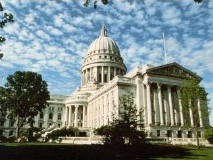While the state is much better prepared to handle economic turmoil than it was during the Great Recession, current reserves and coming federal aid of some $1.9 billion may not be enough to manage a prolonged downturn, state and local finance experts say.
A Legislative Fiscal Bureau memo over the weekend laid out the expected money the state will receive from the federal coronavirus relief package signed into law Friday. Wisconsin is in line to receive nearly $2.3 billion, including $1.9 billion directly to the state. According to LFB, there is no legislative oversight for that money.
According to the LFB memo, three communities with populations of at least 500,000 are in line to receive $360.6 million of the coming stimulus money: Milwaukee County for $164.5 million; Milwaukee for $102.7 million; and Dane County for $93.4 million.
Former state budget director Michael Heifetz, who served under Republican Gov. Scott Walker, told WisPolitics.com the state is “reasonably well-prepared” for a slipping economy in the short term. But he said the state wouldn’t be able to sustain funding beyond “weeks or a short number of months” without assistance from the federal government.
“It’s hard to plan for a complete shutdown of the U.S. economy,” Heifetz, who currently works as health care chief executive for Infinite Policy Solutions, said before the LFB memo was made public. “It’s all hands on deck. Anything that isn’t a necessity is probably being very critically analyzed.”
President Trump on Friday signed into law a $2 trillion economic relief package that would deliver roughly $150 billion to state and local governments.
Pew Research Center’s Stateline service reported that the money in the bill for state and local governments allows “some flexibility” on how it could be spent but does not address diminished tax collections caused by the slowing economy.
Pew said the money would be distributed to states based on population, but that every state would receive at least $1.25 billion, with 45 percent of a state’s money saved for local governments over 500,000 residents.
Gov. Tony Evers is already proposing a state relief package of more than $800 million.
Before current events, LFB announced at the beginning of the year that the state was expected to collect an additional $818.2 million in tax revenue over the biennium, with about half going into the rainy day fund. The budget stabilization fund totaled $654 million at the end of February, according to the latest State Investment Fund earnings report.
A recent Pew analysis of states’ rainy day funds ranked Wisconsin 40th in how many days it could run on total balances (35.3). But the research did find this was the highest balance relative to spending for the state in the last 20 years.
Wisconsin Policy Forum Research Director Jason Stein said the combination of the rainy day fund and remaining general revenue amounts to slightly less than 10 percent of the state’s roughly $17.5 billion in 2019 GPR expenditures.
He called the numbers a “huge improvement” from Wisconsin’s situation going into the 2007-08 Great Recession with under 2 percent GPR expenses in reserves and close to nothing in the rainy day pot. But he added that ultimately wouldn’t be enough if nothing changes in the coming months.
“If you weren’t taking in revenue at all, and you were spending out of the general fund at your average daily rate, that would last you roughly five weeks,” Stein said before the estimate from LFB was made public.
Stein added the state unemployment insurance fund is in its strongest position in decades with more than $2 billion, including $1.9 billion in cash. But a February U.S. Department of Labor report found the fund still fell short of federal unemployment insurance recommendations and ranked 30th among states on that metric.
“We’re in much better shape than we were, but the difference is we were among the least prepared states in the country and now we’re in the middle of the pack,” Stein said. “That’s a big improvement, but it’s not the same as being top of the class.”
The Department of Workforce Development so far received 197,157 UI applications since March 15.
Meanwhile, a record 3.3 million people filed for unemployment benefits nationwide last week. The previous weekly record was 695,000 set in 1982.
Stein warned the state could take up to a 14 percent GPR hit in a “moderate-to-severe” recession scenario. And local governments, which he said typically operate with razor-thin budgets already, wouldn’t be able to get significant stimulus from the state due to its own economic troubles.
Wisconsin Counties Association Research Director Dale Knapp told WisPolitics county budgets “have been tight for quite a number of years and this is obviously going to put some strain on them.”
He estimated up to a 13 percent decline in county sales tax revenue due to Evers’ stay-at-home order and the loss of hotel and restaurant sales, in addition to a spending hike in services.
“At first blush it doesn’t look like a big hit, but when you’re already operating at tight margins you have got to figure out how to deal with those types of productions,” Knapp said. “Any hit to your revenue source is cause for concern.”
Analysts largely agreed that although the dropoff is steep, it’s a real possibility that the economy could see a quick rebound whenever the pandemic is tamed. Heifetz highlighted this as one key difference between today and 2008.
“When the Great Recession was occurring, I’m not sure if we knew there was a bottom or if there was a known end,” he said. “The economy itself today is foundationally strong. We can get back when this is gone, and that wasn’t the case in 2008.”
On Saturday, Evers proposed the Legislature take up a more than $800 million package to address the pandemic.
Evers’ plan would, among other things, give the Department of Health Services unlimited spending and position authority during a public health emergency, as well as halt the enforcement of voter ID, ban evictions and prevent layoffs of school employees during a health emergency.
The biggest pieces of the package include: up to $300 million for the Department of Military Affairs; up to $200 million for the Department of Administration; $100 million to expand programs for the working poor; and $100 million in grants to health care providers.
The package also would provide local governments with a 1 percent increase in aids for 2020, a boost of about $7.5 million.
See Evers’ bill here.
Read the LFB memo on the federal stimulus here.
See more:
https://www.pewtrusts.org/en/research-and-analysis/articles/2020/03/18/states-financial-reserves-hit-record-highs
https://wispolicyforum.org/research/ready-for-recession-recent-financial-gains-will-help-but-may-not-be-enough/
https://dwd.wisconsin.gov/covid19/public/ui-stats.ht
–WisPolitics.com






